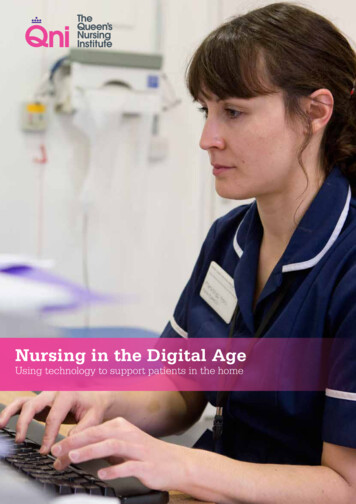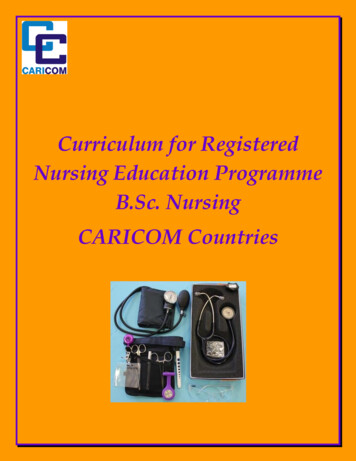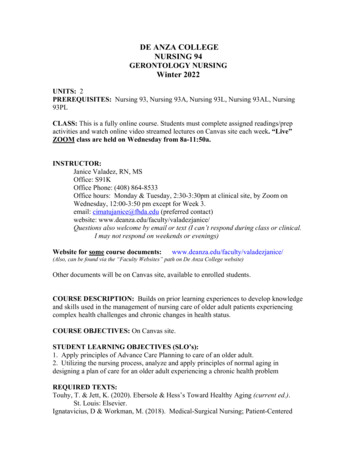
Transcription
Nursing in the Digital AgeUsing technology to support patients in the home1
The Queen’s Nursing InstituteThe Queen’s Nursing Institute is a charity dedicated to improving nursing care forpatients at home and in the community.We work with nurses, managers and policy makers to make sure that high qualitynursing is available for everyone in their homes and communities. Our aim is to ensurethat patients receive high quality care when and where they need it, from the rightnurse, with the right skills.Today we improve nursing in the home:2 By funding nurses’ own ideas to improve patient care and helping them developtheir skills through leadership and training programmes. Through our national network of Queen’s Nurses who are committed to thehighest standards of care and who lead and inspire others. By influencing government, policy makers, and health service planners, andcampaigning for resources and investment in high quality community nursingservices. By supporting community nurses working with people who are homelessthrough our Homeless Health Programme which provides news, guidance andworkshops. By listening to nurses and developing resources and guidance to support them. By offering financial assistance to community nurses in need and providing grantsfor community nursing courses. By encouraging social interaction between current Queen’s Nurses and retiredQueen’s or community nurses through our telephone project, ‘Keep in Touch’.Copyright: The Queen’s Nursing Institute 2018
ContentsForeword4Summary and recommendations8Introduction10Methodology10Chapter 1: The use of information technology in community nursing13Chapter 2: Data management19Chapter 3: Information technology and effective working26Chapter 4: Engaging community health professionals33Chapter 5: Engaging patients39Conclusion44References453
ForewordMost of us recognise that the digital agenda has accelerated in the six years since the Queen’sNursing Institute (QNI) published ‘Smart New World’ in 2012. The changes are experiencedby all of us in our day to day lives and are evidenced by recent statistics that show that almost 9 in10 people say that they have recently used the internet. We know in our personal lives things arechanging but what is happening in the provision of community nursing services?In this report the QNI seeks to assess how community nurses, and the services they work for, areresponding to the opportunity that this fast-paced digital agenda offers. As you might expect, thethings community nurses told us are mixed and reflect a wide range of views, but there are no realsurprises.They told us that there is even more potential to lever the opportunities that technology createsbut it will take investment and leadership. Technology done well can create more efficient servicesbut takes up-front investment. To implement technology well it takes great leadership from nursesand the system is slow to create the Chief Nursing Information Officer (CNIO) role in communitysettings. If we are to lever the benefits of technology, leadership from practitioners who understandthe unique challenges of providing care in the home and community is essential.The nurses gave us evidence that things are positively changing with around 75% of communitypractitioners using electronic systems, but of course once the systems bed-in, nurses rightly askfor more developments, citing the need to be able to share information across care settings as areal and current issue for them; the need for interoperability of systems being evidenced in thevoices of the nurses who responded to the survey.I was surprised by the number of different systems used by the community nurses who respondedto our survey – 67 different systems were mentioned. This leads me to reflect that we need dataand system standards for community nursing that support consistent approaches to the recording,coding, entry and viewing of information about community care.After reading the report I reflect that we are at the cusp of a great opportunity to use technologyto really accelerate the contribution of community nurses to the wide system changes we need.The possibilities of managing caseloads alone, to free resources, and to ensure we have the rightpractitioners, in the right place, at the right time, to meet the needs of patients, seems to havegreat potential.Some things, however, don’t change and as in 2012, we still need to focus hard on culture changesto see the real integration of technology and data into nursing practice. We also need to seepatients’ involvement as key; they are an untapped resource that community nurses should activelyseek to engage in the digital agenda.Anne CooperQNI Fellow and Chief Nurse, NHS Digital4
5
Summary and recommendations6
Information technology presents one of the greatestopportunities to make services more efficient and help managepatient need in a sustainable and equitable way.In the last generation, information technology has transformed our society; from purchasing commoditiesto managing our finances and accessing entertainment, our lives have undergone a technologicalrevolution that continues to accelerate. This has created enormous opportunities for those swift to adoptnew technologies, but it also poses serious and fundamental risks for those left in their wake. For various andcomplex reasons, health services in the UK have found it challenging to keep up with the pace of change.Information technology is transforming care, as new treatments and diagnostic tools become available,procedures are undertaken in a less traumatic way, communication between professionals is easier thanever before and geography is less of a barrier, patients both own health equipment and are increasinglyaccessing their own records.There is still, however, resistance or reluctance when it comes to utilising the full range of new informationtechnology in the healthcare environment. Some parts of the health service still display reliance on olderforms of technology, such as fax machines and paper-based records, which have largely been superseded inother sectors. With information communicated by relatively slow and sometimes unreliable means, someproviders are not taking advantage of the efficiencies that new IT systems can bring. In addition, patient careis more susceptible to becoming disjointed and risks are amplified.Information technology presents one of the greatest opportunities to make services more efficient andhelp manage patient need in a sustainable and equitable way. This is an area in which NHS bodies andthe Department of Health have shown leadership. The Five Year Forward View sets out plans to embracetechnology and ‘exploit the information revolution1’ and Secretary of State for Health and Social Care,Jeremy Hunt, has called for a ‘Paperless NHS’ by 2020.In 2012, The Queen’s Nursing Institute (QNI) published ‘Smart New World’, a review of information technology(IT) in community nursing provider services. This presented ways in which IT was used in the community toempower patients and complement the expertise of nurses. The report highlighted the significant diversitythat existed at that time between different NHS employers and even different teams. Six years later, thisnew report illustrates how IT is being used in community nursing services now, from the perspective of thestaff at the point of care. From a survey of 534 community health professionals, the following was identified: 67 differently named IT systems are used in community healthcare;74% of community nurses find IT systems a more reliable way of working, compared to paper;29% of community nurses are still working largely with paper based systems;41% of NHS trusts do not use telehealth systems;28% of services utilise a text messaging facility to remind patients of their appointments.Overall, community nurses are willing to engage with information technology recognising that this is a newway of working will eventually enable better patient care and increase productivity. The survey, however, alsoidentified barriers to IT being utilised in the most effective way: The systems used in community healthcare are sometimes outdated and often do not always representthe most efficient solutions. Information technology has not been tailored to community nursing. Limited consultation has takenplace with practitioners about their use of IT at the point of care. Systems have been adapted andapplied to community nursing without fully considering the complexity and different needs of this sector.7
Poor connectivity hinders efficient ways of mobile working. A lack of and/or limited connectivity meansthat some systems do not update, synchronise or function. This leads to nurses spending time duplicatinginformation as paper records are transferred onto systems back at base. A multiplicity of IT suppliers has led to the use of databases and systems which are incompatible withone another.RecommendationsIn order for information technology to facilitate more productive ways of working in the community, the QNImakes the following recommendations:To funding organisations: Provide appropriate levels of funding that is ring-fenced for the purpose of digitising communityhealth services. Long-term, funding should be provided to enable information technology to be fullyimplemented and supported. Standards should be developed to support consistency across the health and care system. There is arecognition that it is not possible to implement a single system; the use of standards means that staffwill recognise and understand the information to be recorded whatever the system they are working in. Systems are developed specifically for staff that work in community settings, working with staff whodeliver care, in order to ensure they are fit for purpose. Systems must be interoperable to permit information to be shared securely to support the care ofpatients.To service providers:8 Consider appointing a Chief Nursing Information Officer who leads on the implementation of informationtechnology and works collaboratively with IT support and system developers to ensure clinical needsare reflected. Commission only systems that are designed in collaboration with their users. Work with the appointed clinical leads to support employees to receive training in using informationtechnology. This should be tailored to the individual and/or team and regular updates should be provided. Actively involve clinicians in the re-design of systems and any decisions regarding information technology. Include patients in telehealth initiatives and formally risk assess every patient to ensure the new way ofworking is suitable for them and their needs. Recognise and report on the value of mobile working to service users and the workforce.
Introduction9
Digital tools are now an integral part of our personal dailyroutine, with mobile phones and the internet now deemed tobe essential to our everyday lives.Digital tools are now an integral part of our daily routine, with mobile phones and the internet nowessential to our everyday lives2. For businesses and service providers also, information technology isindispensable in every aspect of customer service and relationship management. This is the environmentin which the NHS is now operating. NHS England’s ‘Five Year Forward View’ set out plans to embracetechnology and ‘exploit the information revolution3’ and the Secretary of State, Jeremy Hunt, has called fora ‘Paperless NHS’ by 2020. There has been significant investment in ‘Global Digital Exemplar’ Programmewith a focus on the hospital sector and on mental health services but no direct investment on communitysettings. Furthermore, 2017 saw the launch of the ‘NHS Digital Academy4’ , which will train and support ChiefInformation officers, senior clinicians, and aspirant digital leaders to drive the NHS’ digital transformation. InAugust 2017 NHS Digital launched e-nursing week, which advocates for a digital workforce and supports theRoyal College of Nursing’s ‘every nurse an e-nurse’ campaign5.Attempts to digitise the health service are not new; in 2005, the UK’s National Programme for InformationTechnology (NPFIT) was introduced. Whilst this bolstered some success, particularly with regard toimplementing a secure email and GP record transfer, the community and hospital sectors failed to digitise6.When the programme ended in 2011, it was stated that ‘little clinical functionality has been deployed todate7’.In 2012, The Queen’s Nursing Institute (QNI) published ‘Smart New World8’. This report highlighted the waysin which technology was being utilised to provide patients with a sense of involvement and control in theircare, alongside the ways in which nurses could deploy information technology to complement their expertise.It was evident from this study that implementation of information technology is inconsistent.Six years later and amid a growing awareness of the role technology can play within the provision ofhealthcare, the QNI set out to explore how information technology was currently being utilised in communitynursing services. This new report presents the views of community healthcare professionals, explores howtechnology is currently used in a professional context and identifies the barriers to a full-scale adoption.MethodologyUnless stated otherwise, all information in this report was generated by the QNI.Utilising a core group of community nurses, a survey was designed and piloted; following which it was sentto all QNI contacts (c. 8500) via SurveyMonkey. The survey was open for three months during which 534responses were received from a broad range of professionals including advanced nurse practitioners, clinicalleads, community matrons, district nurses, community staff nurses, directors of nursing, service managers,specialist nurses and team managers.10
As Figure 1 shows, most respondents worked in England, Wales and Northern Ireland, with some in Scotlandand other parts of the United Kingdom9.Figure 1. In which area do you work?The survey consisted of twenty-three questions, each giving the opportunity for comments to be made.The concluding question of the survey also provided respondents with an opportunity to share their generalperspectives on the role of information technology in healthcare.11
Chapter 1 - The use of information technologyin community nursing12
The opportunity for patients to actively engage with theirhealth and care has never been greater.Healthcare in the 21st Century offers one of the most dynamic environments for the development ofinformation technology. It offers huge potential to clinicians, including community nurses, who delivercare in a wide variety of settings including people’s homes, in outreach work, in clinics and in GP practices.Equally, the opportunity for patients to actively engage with their health and care has never been greater.Advice is only a click away using ‘NHS Choices’, which averages around forty million views each month10. Inturn, technology has permitted a more preventative self-managed approach to health, averting unnecessarycontact with services. Information technology is also increasingly being utilised in initiatives seeking tomanage demand, support patients and professionals and prevent ill-health.The QNI’s survey reflected that information technology (IT) is used in all areas of community healthcare. AsFigure 2 illustrates, IT is used widely, ranging from more long-established tools to newer platforms, such associal media.Figure 2. Thinking of your professional role, in what way do you use technology?Nurses use IT to communicate both with patients and other health professionals.The survey found thattechnology was used to contact patients directly, by text or email, about their care, but was also used as away of engaging with and educating the public more widely. This included video content and websites toprovide education and advice, whilst social media was used as a way for services to be contacted and adviceto be accessed by service users. IT was also used to facilitate communication between health professionals,with email and conference calls cited most frequently. However, older means of communication, such as fax,were still reported to be frequently used in a professional context.13
Respondents described diverse ways in which IT supports service delivery, including electronic prescribing,diagnostic tools, data collection, updating patient records and referring patients to specialist services. Thestudy also identified more innovative ways in which technology was utilised, such as monitoring woundsthrough photography, eClinic instant messaging and virtual consultations. Furthermore, a number of servicesutilise technology to provide triage and single-point-of-contact services to ensure the most appropriate healthprofessional was responding to a patient’s needs.‘Telephone triage I find efficient and a good way to prioritise care.’‘SPOC [single-point-of-contact] service increases productivity, as calls to the DN [District Nurse] service arefiltered and signposted to the appropriate professional.’Community health professionals are also using IT for education and professional development. Whilst somerespondents reported that they incorporated a range of devices and programmes through teaching, othersspecified opportunities for research and learning, such as remote apps or e-learning.In addition, information technology plays a significant role in the administrative side of community healthcare,with respondents citing its use in terms of processing expense claims, financial recording and recruitment.Telehealth and workforce planning are two areas in which information technology has significant potential todrive change in the provision of community healthcare. However, the study has identified that the degree towhich these are currently used is very mixed.TelehealthOver fifteen million people in England are thought to have a long-term health condition, with this figureexpected to rise significantly over the next ten years11. When it comes to ways in which long-term conditionscan be managed by patients in their homes, telehealth is of growing importance. Telehealth is essentially anymeans of monitoring physical metrics and supporting health interventions remotely. This involves patientshaving devices or applications that monitor their health condition and permit health professionals to overseepatients’ progress without having to arrange face-to-face appointments.The survey found that telehealth was used to varying degrees within community nursing service providers.As Figure 3 illustrates, 41% of respondents said that telehealth was not used within their organisation andof the 59% who said it was used; only 16.3% used it on a regular basis.Figure 3. How widespread is telehealth in your organisation?14
Whilst those respondents whose organisations regularly utilised telehealth were in the minority, they didreport that it had become an essential component within their service.The survey found that ‘use’ ranged from particular members of staff, to whole teams. Telehealth was alsoused to support patients with particular conditions, for example Chronic Obstructive Pulmonary Diseaseand those receiving treatment related to wound care. Respondents also reported that geographical locationoften determined the degree to which telehealth was used, with higher rates of use in rural and moreremote areas.In cases where telehealth was utilised, the survey identified that patients’ conditions were often monitoredby a wide range of health professionals. This included nurses, practice managers, specialist services andcommissioned teams.Figure 4. Where telehealth/remote monitoring is used, who is responsible for monitoring the patient’scondition/health status?District Nursing Service28.9%General Practitioner15.7%Community Matron32.1%Specialist service linked to a long termcondition47.4%Secondary care6.3%Other17.4%As Figure 4 shows, almost half of respondents (47.4%) reported that specialist services were responsiblefor monitoring a patient’s condition. The survey also identified that community matrons and district nursingservices also had a significant level of responsibility, 32.1% and 28.9% respectively, with general practitioners(GPs) cited less frequently (15.7%). Nurses often perform a gatekeeping and triage role, liaising with GPsas necessary.The survey also highlighted the use of ‘health hubs’ that provide a wealth of services from a central point.The way in which these were administered varied. Some were run by frontline staff, while others said thattheir health hub was administered by a dedicated team who would alert community nurses to any changesin a patient’s condition. Several respondents considered that health hubs were a more efficient way ofmonitoring conditions.‘We think a hub might also work better with alerts sent to the matrons, so they don’t have to keep checkingthe systems.’In contrast, as Figure 3 shows, a significant proportion of respondents (41%) reported that telehealth wasnot used at all by their organisation. In some cases, the necessary hardware was simply not available. Somerespondents indicated that although their organisations had utilised telehealth previously, it had since beendiscontinued. The reasons cited for this ranged from poor evaluations, cost, to improper use.‘It was used three years ago and abandoned as the data collected was not then acted upon. This fell ontoprimary care, GPs etc. who didn’t want that responsibility.’‘We used to be very involved with local telehealth, and were encouraged to enable patients to access this.However, this has diminished by the loss of community matron function.’15
‘[Telehealth] was used initially within the long-term conditions team but evaluated poorly so no longer in use.’‘Tried in the past but then withdrawn. Not targeted at the right patients in my opinion. Telecare e.g. fallsensors, bed sensors, heat smoke, flood sensors often more useful for frail elderly patients.’Where telehealth was available, it was not always being utilised fully. Respondents stated that support andtraining was not sufficient and this hindered its use.‘I think it is available but I do not know how to access it and what they can do.’‘ due to redesigning and restructuring, in my opinion, nobody is able to monitor the patients, as they donot know how to.’Workforce planningA significant amount of NHS activity is attributed to community services, with approximately 100 millionpatient contacts taking place each year12. Current policy envisages an increasing move towards to caredelivery in the community and primary care, leading to growing pressure on community nursing teams.Efficient workforce planning and caseload allocation is vital if services are to respond to increasing demand.The term ‘patient caseload’ is attributed to a specific group of patients to whom a service is provided. Staffare allocated a caseload in accordance with local workforce plans, ensuring those with the right skills are inthe right place at the right time – so that individual patient needs are met by staff with the right skills andexperience.Information technology presents new and unique opportunities for workforce planning and the surveyidentified a plethora of systems that seek to do this. These ranged from widespread tools such as Emis,Systm One and RIO to bespoke in-house systems. However, only 32.7% of all respondents reported thatworkforce planning tools were used in their teams.Figure 5. How is staff allocation undertaken in your organisation?Respondents had mixed views when it came to using ane-roster. It was seen as a tool that had thepotential to yield real benefits in allocating and planning work, but implementation was hindered in somecases by a lack of investment.‘I find electronic allocation of work to be useful and [it] speeds up the process.’16
‘We would love e-rostering, but investment funds are not there and we need a major change programme toprepare the ground, as we are struggling with the capacity of frontline teams and support staff.’Those working in teams where e-rostering was used, considered that its implementation was not as effectiveas it should be. Whilst some respondents believed its introduction had been too slow or patchy, othersthought it had been established too quickly, leading to further problems.‘This has just been rolled out within a ridiculously short-time and with inadequate support, manpower andno staff training.’Others felt that it was not suitable to their local service context.‘The dreaded e-rostering is coming. As we have various means of delivering care in our area, the e-rosteringis not suitable but as it is a national requirement, we are being forced to implement it.’As Figure 5 shows, 67.3% of respondents said that workforce planning was undertaken manually by amember of staff. The member of staff responsible varied from one locality to another and included teamleaders and dedicated admin staff. Where e-rostering was used, team leaders usually retained primaryresponsibility for its management.The survey identified a range of ways in which workforce planning was undertaken. This included: settingcaseloads for those working permanent shift patterns, communication with colleagues, staff meetings andindividual caseload management.In some cases, staff allocation was shared by the team as a whole, while others were determined by localityand geographical boundaries.‘Now workforce modelling is based on [levels of social] deprivation and city council boundaries.’Despite an abundance of workforce planning tools and systems, the study found that these were oftenoverlooked by service providers. As with many aspects of technology, resistance to new IT may be connectedto perceptions regarding its reliability. Some respondents were openly sceptical and believed more patientswere missed with electronic allocation systems.It was also the case that electronic forms of workforce planning were often not utilised, or not used to fulleffect, due to workloads being dependent on the reality of staff availability and numbers.‘E-rostering will be coming to us soon; at present it’s done by a mixture of team leaders, district nurses andclerical staff and it is chaotic – mostly because we are haemorrhaging staff and have to staff early and lateshifts, triage new referrals, staff the leg ulcer clinic, the rotas for those can be sensibly planned but needrearranging weekly due to changes in staffing.’‘We just get our heads down and get through the visits as best we can.’17
Chapter 2 - Data management18
While the survey identified a range of devices currently beingused, many respondents felt that some were better suited thanothers.One of the most significant consequences of the use of information technology is the generation ofaccessible data. In theory, this permits information to be shared amongst health professionals, enablingcare to become more coordinated, clinical decisions to be better informed and timely and for patients toexperience a more joined up provision of care. This wealth of data also permits new insights. On an individuallevel this allows preventative action to be taken and helps make referrals to more specialist services. At alocal and national level, information can provide insights about population health, helping to inform decisionsabout resource allocation.Capturing informationAs illustrated in Figure 6, community health professionals use a range of devices to capture information. Thestudy identified that devices such as laptops are more frequently used compared to compact devices suchas tablets, iPads and smartphones. 31.9% of respondents used a combination of paper and IT methods.Figure 6. Which device do you use to capture information data?Tablet9.5%iPad11.1%Laptop44.1%Paper then transfer to IT system back at base29.0%Mixed - paper & tablet/PA laptop/other31.9%Smartphone14.7%Other (please specify)17.9%While the survey identified a range of devices currently being used, many respondents felt that some werebetter suited than others. Often, devices currently being used in community nursing services were perceivedas being unsuitable with little, if any consultation, having taken place with those actually using these devicesprior to their introduction.Laptops44.1% of respondents used laptops to capture information (see Figure 6). However, some found themoutdated and cumbersome. Challenges also arose because software on these devices was often inadequateand connectivity could be difficult. Work done on laptops in the patient’s home often needed to be duplicatedlater onto another system at the office.‘Most DNs [District Nurses] use paper even though laptops are available. They are heavy and Wi-Fi is notavailable at the team base.’‘I prefer to wait until I’m back at the desk and use the desktop as the laptop is so slow; it is quicker to driveback.’19
‘Really effective when it works adequately but substantial amount of time wasted due to inadequateequipment. I.e. Laptops are not fit for purpose due to issues with signal, memory etc. which is frustratingat times.’Several respondents felt that newer devices were better. However, just 11.1% reported using iPads and9.5% used tablets, with rollout cited as being slow, either in its infancy or just piloted in select teams. Oneof the most significant factors limiting the use of these devices was the financial pressures NHS trusts arefacing, hindering the integration of these devices into care.A number of respondents did not feel that tablet devices were suitable for mobile working. This was in partdue to improper versions being provided (particularly the case for iPads), limited connectivity, cumbersomeset-ups and difficulties inputting information.‘We have to struggle with an iPad mini with no keypad docking station to make typing easier. Instead ofbeing
implementing a secure email and GP record transfer, the community and hospital sectors failed to digitise6. When the programme ended in 2011, it was stated that 'little clinical functionality has been deployed to date7'. In 2012, The Queen's Nursing Institute (QNI) published 'Smart New World 8'. This report highlighted the ways











